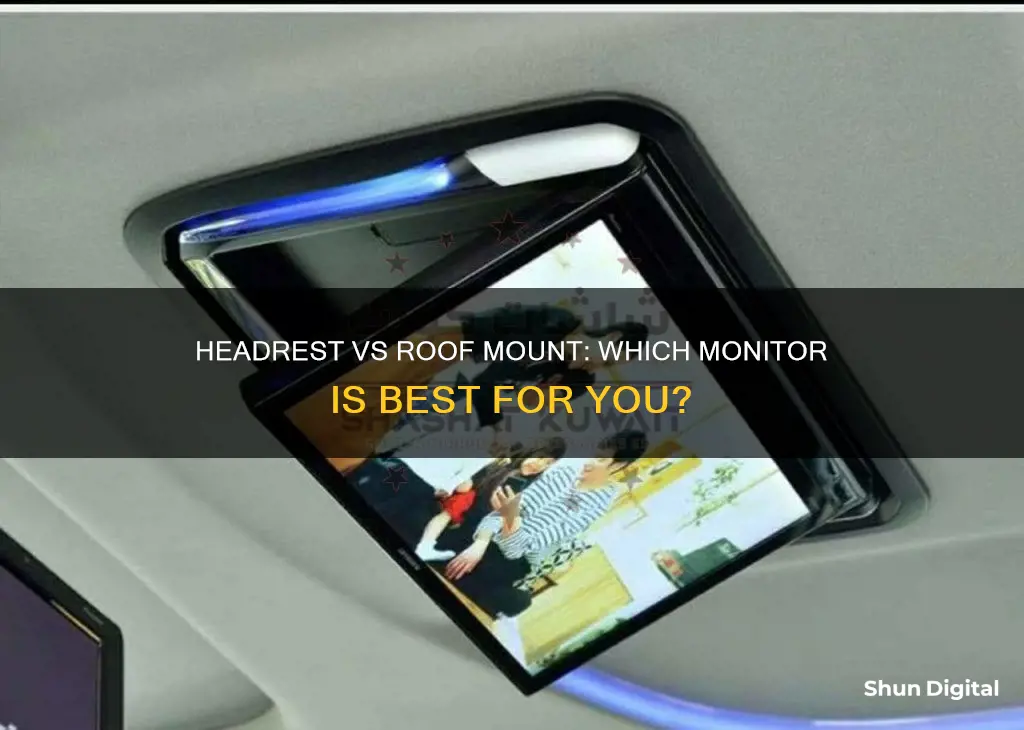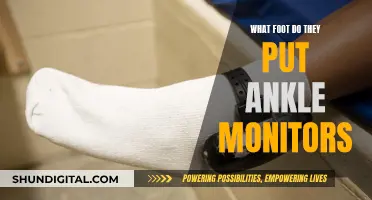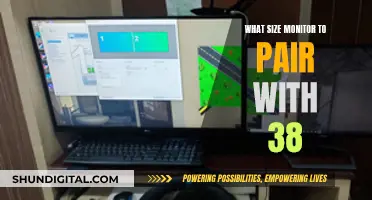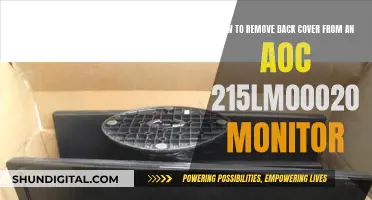
If you're looking to keep your kids entertained on long car journeys, you might be considering installing a monitor in your car. Two options are headrest monitors and roof-mounted, or overhead, monitors. Headrest monitors attach directly to the back of a car seat's headrest and usually include a DVD player and an SD slot, while overhead monitors are connected to the roof of a car and flipped down when in use.
Both options provide entertainment for passengers, but there are some key differences to consider when deciding which one is right for you.
| Characteristics | Values |
|---|---|
| Installation | Headrest monitors are easy to install and can be purchased as add-ons or separately. |
| Ease of use | Headrest monitors are within easy reach and often come with remote controls. Passengers can also use headphones to avoid distracting noise. |
| Entertainment | Headrest monitors are a great way to keep passengers entertained, especially on long journeys. They allow passengers to watch movies, browse the internet, play games, and listen to music. |
| Compatibility | Headrest monitors are compatible with various media devices, including smartphones, tablets, and gaming consoles. They support different formats like MP3, MP4, WMA, AVI, and DVD. |
| Size | Headrest monitors typically range from 7 inches to 15.6 inches. Larger screens provide a more immersive viewing experience, while smaller screens are more compact and suitable for smaller vehicles. |
| Connectivity | Headrest monitors offer wired and wireless connectivity options, including HDMI, Bluetooth, WiFi, USB, and SD card ports. |
What You'll Learn

Headrest monitors for in-car entertainment
Headrest monitors are a great way to keep your passengers entertained on long journeys. They are a good option if you have children and are looking for an in-car entertainment system that is safe and doesn't distract the driver.
Headrest monitors are screens that attach directly to the back of a car seat's headrest. They are primarily used for entertainment and typically include a DVD player, an SD slot, and run on the Android operating system. They can be purchased as add-ons when buying a new car or separately and connected to a headrest using straps.
Features of Headrest Monitors:
- DVD Player: Headrest monitors often include a DVD player, making them ideal for those who want an easy-to-use option.
- SD Card Reader: Some headrest monitors have an SD card reader, allowing you to save media onto an SD card and play it in your car. This offers more storage than a DVD player.
- Android Operating System: High-end headrest monitors with Android offer increased functionality, allowing users to install any app, play games, and browse the internet, in addition to watching movies.
- Phone Connectivity: Many headrest monitors offer smartphone connectivity, allowing you to stream content directly from your phone.
- HDMI Input: HDMI input enables you to connect a range of other devices, such as a games console, for a seamless gaming experience in your car.
- Headphones: Headrest monitors often come with wireless headphones, ensuring a private listening experience for passengers.
Benefits of Headrest Monitors:
- Safety: Headrest monitors are positioned so they don't interfere with the driver's field of view, making them a safe option for in-car entertainment.
- Ease of Use: These monitors are within easy reach and often come with remote controls, making them convenient for passengers to use.
- Entertainment: Headrest monitors provide a range of entertainment options, from watching movies and listening to music to playing games and browsing the internet.
- Compatibility: Headrest monitors are compatible with various media devices, and their screens range from 7 inches to 15.6 inches, catering to different vehicle sizes and passenger needs.
Factors to Consider:
When choosing a headrest monitor, consider the installation process, multimedia compatibility, connectivity features, and user-friendly controls. Additionally, screen size is important, so select a size that enhances entertainment while keeping everyone in the vehicle engaged.
In conclusion, headrest monitors are a great option for in-car entertainment, offering safety, convenience, and a range of entertainment options for passengers.
Removing Black Spots from Your LCD Monitor
You may want to see also

Roof mounts for multiple passengers
When it comes to in-car entertainment, roof-mounted monitors are a great option for multiple passengers. Here are some key advantages of roof mounts over headrest monitors:
Multiple Passengers
One of the biggest advantages of roof-mounted monitors is that they can accommodate multiple passengers viewing the screen simultaneously. This makes them ideal for families or groups travelling together. With a roof-mounted monitor, everyone can enjoy movies, shows, or games together, creating a shared entertainment experience.
Space-Saving
Roof-mounted monitors are installed on the roof of the car, usually parallel to the roof and then flipped down when in use. This installation method saves space in the car cabin, making it a better option for smaller vehicles where headrest monitors might be too bulky or obstruct the driver's view.
Ease of Installation
Roof-mounted monitors often come with universal mounting brackets, making installation a breeze for a wide range of car models. They are typically installed once and don't require frequent adjustments, unlike headrest monitors that may need to be strapped on and adjusted for different passengers.
Versatile Connectivity
Like headrest monitors, roof-mounted monitors also offer a range of connectivity options. They usually feature HDMI input/output ports, enabling easy connection to external devices such as smartphones, tablets, gaming consoles, or DVD players. Some models may also offer wireless connectivity via Bluetooth or WiFi, providing seamless streaming of audio and video content.
Adjustable Viewing Angles
Roof-mounted monitors can often be adjusted for different viewing angles, ensuring a comfortable viewing experience for all passengers. They can be tilted, swivelled, or adjusted to find the perfect angle for each passenger's comfort.
When deciding between headrest and roof-mounted monitors, it's important to consider your specific needs and preferences. If you frequently travel with multiple passengers who want to view the same content, a roof-mounted monitor is a more suitable option. It provides a shared entertainment experience while saving space and offering flexible installation and connectivity options.
Syncing Wireless Keyboards to Monitors: A Step-by-Step Guide
You may want to see also

DVD players and HDMI compatibility
DVD Players:
DVD players are a great way to keep your passengers entertained, especially on long drives or road trips. When it comes to headrest or roof-mounted monitors, many models offer built-in DVD players, providing a convenient all-in-one solution. This eliminates the need for separate DVD players and ensures a seamless viewing experience.
HDMI Compatibility:
High-Definition Multimedia Interface (HDMI) compatibility is crucial for connecting external devices and ensuring a high-quality audio-visual experience. Many headrest and roof-mounted monitors feature HDMI input/output ports, allowing you to connect smartphones, gaming consoles, or additional DVD players. This versatility enhances your in-car entertainment options.
When choosing a monitor, look for one that supports HDMI input and output. This will enable you to connect a variety of devices and ensure compatibility with future technologies. Additionally, consider the number of HDMI ports available, as you may want to connect multiple devices simultaneously.
Some monitors also offer wireless connectivity options, such as Bluetooth or WiFi, which provide alternative methods for streaming content from your devices. However, if you plan to use a DVD player extensively, ensure that the monitor supports HDMI connections for the best audio and video quality.
In summary, when deciding between headrest and roof-mounted monitors, consider your DVD player needs and HDMI compatibility. Both types of monitors often include built-in DVD players, and HDMI connectivity is essential for connecting external devices and future-proofing your setup.
Monitoring Xbox Usage: Mbit's Parental Control Guide
You may want to see also

Safety considerations
When considering adding headrest or roof-mounted monitors to your vehicle, several safety factors should be carefully thought through to ensure a secure and enjoyable experience for all occupants.
Firstly, it is imperative to select a monitor that does not obstruct the driver's field of view. This is a critical safety measure to prevent distractions and maintain clear visibility for the person operating the vehicle.
Secondly, the installation process must be done correctly to ensure the monitors are securely mounted. Whether you opt for headrest or roof-mounted monitors, follow the manufacturer's instructions precisely to avoid any potential hazards caused by improper installation. This is particularly important for headrest monitors, which are often strapped on, to prevent them from being knocked off during aggressive driving conditions.
Thirdly, consider the placement and viewing angle of the monitors. Headrest monitors are generally positioned within easy reach of passengers and often come with remote controls, reducing the need for passengers to lean forward or shift positions, which could be a safety hazard. Roof-mounted monitors, on the other hand, are installed parallel to the roof and flipped down when in use. While they offer a good viewing experience for multiple passengers, they may not be suitable for smaller cars due to space constraints.
Lastly, to minimize distractions for the driver, it is recommended to provide headphones for passengers, especially when multiple monitors are playing different content simultaneously.
By carefully considering these safety aspects, you can ensure that your chosen in-car entertainment system enhances your journeys without compromising the safety of you and your passengers.
Choosing an LCD Monitor: Key Considerations
You may want to see also

Installation processes
The installation process for headrest monitors and roof-mounted monitors varies. For headrest monitors, the process typically involves mounting the monitor onto the headrest posts of the car seat. Some models come with universal mounting brackets for easy installation, while others might require hardwiring cables into the car. This involves removing interior trim panels and connecting all grounds to the same location using an "add-a-circuit fuse" to the fuse box.
For roof-mounted monitors, the installation is generally simpler and requires only basic wiring skills and non-invasive fastenings to the car's ceiling. However, it is important to ensure that the ceiling can support the weight of the monitor and that you don't drill or screw into any factory wiring or plumbing.
- Replace the headrest posts with hollow ones through which wires can be run. Measure the posts, then remove and unscrew the current posts. Run the wires through the new posts, screw them into the headrest, and replace the headrest.
- Remove the seat-back carefully. Some seat-backs have snaps, while others have screws at the bottom. For fully upholstered seats, lean the seat back, unclasp the back, and pry apart the plastic teeth holding the seat-back to the seat.
- Run the wires down the back of the seat, underneath the metal at the bottom of the seat back, and through the upholstery.
- Connect the wires. There will be two wires: the A/V input and the A/V output, which is also the power cable. Connect them to the corresponding ports, ensuring that you connect the positive and negative sides correctly.
- Connect the DC power jack into the cigarette lighter outlet in the car.
For a roof-mounted monitor, here are the simplified installation steps:
- Survey the area where you want to mount the monitor. Ensure the surface is flat and check for a roof support that can carry the weight of the monitor.
- Remove the dome light to check for reinforcement. You may need to use a pick or a small screwdriver to remove the lens.
- Expose the dome light wiring by carefully prying the dome light from the headliner.
- Locate the metal reinforcement plate. This is where you will attach the monitor mounting bracket to the vehicle.
- Place the mounting bracket on the ceiling, ensuring it overlaps with the reinforcement plate so that you can install at least 4-6 screws to firmly attach it.
- Cut the headliner for firm mounting. This ensures that the monitor doesn't bounce as the vehicle moves.
- Drill or tap the factory sunroof support bracket, being careful not to damage any wiring or plumbing.
- Complete the final wiring and mount the monitor.
It is important to note that the specific steps may vary depending on the make and model of your vehicle, as well as the type and brand of the monitor you choose. Always refer to the manufacturer's instructions and guidelines for the most accurate and safe installation process.
Troubleshooting an ASUS Monitor That Won't Detect HDMI
You may want to see also
Frequently asked questions
A headrest monitor is a device that attaches to the back of a car seat's headrest and is used for entertainment. They often include a DVD player, an SD card slot, and can run on the Android operating system.
Headrest monitors provide in-car entertainment for passengers, especially during long journeys. They are easy to install, and some models have remote controls and headphone connectivity for a private listening experience.
Headrest monitors may be bulkier and more expensive than roof-mounted monitors. They are also typically only visible to one passenger, unlike roof-mounted monitors that can be viewed by multiple passengers.
Consider factors such as your car size, the number of passengers, and your budget. If you have a small car or are looking for a more affordable option, a headrest monitor might be preferable. If you have multiple passengers who would benefit from a shared screen, a roof-mounted monitor could be a better choice.







